
WWE Wows Wrestlers and Fans with Thunderdome Design, Virtual Audience
As the coronavirus pandemic forced a shutdown of events with live audiences, WWE, a juggernaut, touring weekly with live broadcasts on USA Network and Fox in addition to a host of Pay Per View events around the world, was forced to move away from large fan-filled arenas and into the company’s Performance Center in Orlando, a training facility for up-and-coming talent.
As it became increasingly apparent that mass gatherings were not going to happen for many months into the future, WWE wanted to find a way of bringing its fans into an arena through virtual reality. “First and foremost, we considered the safety of our fans and of our superstars and employees,” says Vince McMahon, WWE chairman of the board. “That’s paramount.”
In the process of arriving at a solution, the company proceeded with a very aggressive taping schedule at the Performance Center. This was achieved through the fortitude and perseverance of a team of committed professionals. Jason Robinson, production designer for WWE, while in the midst of shooting a current episode, spoke with PLSN about the critically short timeline in which this new format of entertainment was launched.
On March 12, while in route to Detroit, the production team was informed that everything was shutting down. There would be no event on the 13th from Little Caesars Arena. Trucks were immediately rerouted to the company’s Florida training facility, the WWE Performance Center, to broadcast live the next day on Fox.
Jason Robinson walked into this building and, with 23 trucks of touring elements at his disposal, came up with a look that was appropriate for such large scale television productions as Raw and Smackdown. His team went into action and, within a few days, was ready to hit the airwaves. This would be the setting for the taping of their Monday night Raw and Friday night Smackdown live broadcasts through mid-August.
With a temporary studio in place, WWE began taping the weekly shows, wherein the crew and performers remained quarantined. With a new schedule in place, the crew was able to begin rotating out and getting home for a break before the next series of tapings. “It kept our shows on the air and our crews working during the initial shutdown,” recalls Robinson.
By July, the national quarantine restrictions were beginning to lift somewhat, and the WWE production staff began looking for a scenario to go live every Friday and Monday and to have a bigger show than the PC space allowed. The Amway Center, in Orlando, was their target destination.
“When my original design was submitted to Mr. McMahon, he said he needed more. It needs to be like a big ‘Thunderdome.’ Sometimes it only takes one word for inspiration, and Mr. McMahon gave me the one word,” smiles Robinson. From McMahon’s “go” to the unveiling of the Thunderdome for WWE Smackdown on Fox on Aug. 23, a total of nine days passed. Or to understand a bit better — just 216 hours.
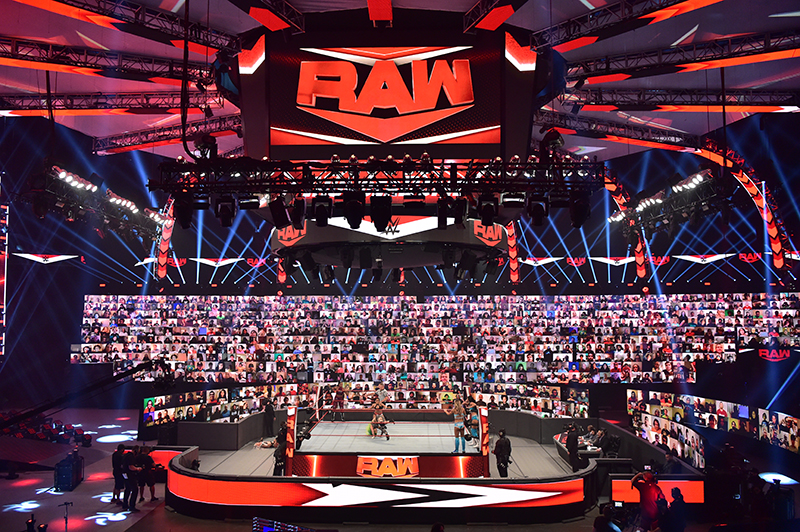
The Reality of Creating the Virtual
“Our first mandate was to create an arena that looks full of people, but with nobody in it, not only for the audience at home but for the performers in the ring. Because the fans in the audience are the third member in that ring — their response energizes the performers. Jeremy Shand, our production manager, and I lined up a bunch of cardboard boxes in the seats to figure out how we were going to create this virtual audience. After seeing other attempts which felt more digital than anything, we wanted to create a background experience that felt like the real thing.”
Robinson came up with a curved layer LED tile creating seven rows of “audience.” They sought a higher resolution for the audience closer to the ring that proportionally decreased the further and higher up the seating layers away from the center of action. The next step was how to populate it, which is where the Famous Group comes in. Famous Group was brought in after the design was complete to populate the virtual audience. Their software technology allows the WWE Universe to sign into the website and be virtually transported to the arena.
Says Robinson, “We told Famous Group, ‘Here is our pixel map, here is what we want you guys to fill.’ It was an education process for both them and us. We had two main challenges to overcome. We wanted there to be no latency and to have all the fans look the correct size. So as the viewers at home watch the show and observe the audience we have created, it feels like they are seeing a live audience on TV.
“It starts with the WWE vision with what they want to create, and give them the credit here for having the vision,” says Jon Slusser, owner and partner at The Famous Group. Slusser notes that whenever the WWE uses its drone camera technology, incorporating a wide angle view, the entire audience, which consists of thousands of fans watching live at home, who might be screaming, cheering, or booing, depending on what is happening at the event, can be seen. “Those moments give me chills, because nobody has ever done anything to that scale before,” he says. “It’s mind-blowing when you see it all put together with all those people, those live faces. “It looks like the future, because it is the future,” says Slusser.
The Famous Group came up with components to this solution. “We had worked with real-time rendering before on a variety of different projects, mixed reality using the Unreal Engine, and we’ve used AWS for our projects, which we’ve used for this. Quince Imaging and Frozen Mountain are our two technology partners, and so we had all of the pieces in place.”
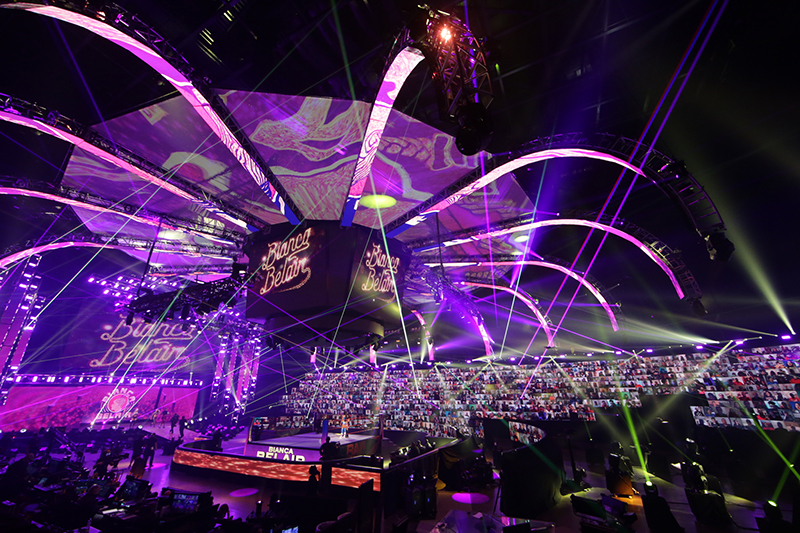
The Shell Gets Shaped
The other half of the nine days was spent creating the Thunderdome. Robinson wanted 16 video fingers to create the frame of the Thunderdome. Among multiple challenges involved with this concept was needing to create a structure with a flat surface to project on and then curving the truss down for the video projection to create the feel of a roof over the audience to the floor.
Robinson and executive VP of television production Kevin Dunn collaborated through constant video chats for two days sending drawings back and forth growing the Thunderdome. “We started with the heartbeat of the center structure, worked our way out to video projection, the legs that came down, the lights on them, to create a roof for that Thunderdome feel for the arena.”
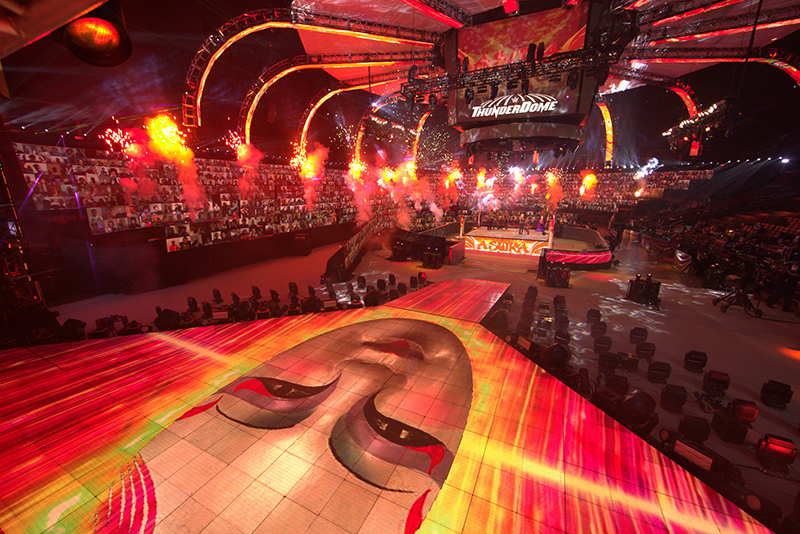
He continues, “These fingers extend over the seats, so we bolted the truss together in the air, then flew it up. Each truss had LED panels, truss toners, projection material, [Claypaky] Sharpys and [Vari-Lite] VL6000’s on the end. No one was left out of putting product on these Thunderdome curves.”
Robinson called Dave Gittens at ARS, asking him, “How many 40-foot circles do you have?” Then adding, “I’ll take ‘em all!” He then brainstormed with Gittens and Kevin Hoyle of Screenworks on getting the 7mm product to curve around a quarter of a 40-foot-diameter circle, and then straighten out the last 30 feet. The next issue was coming up with a way to mount these tiles to the truss. “Dave and Kevin came up with this plate scenario, where you bolted each individual panel onto the truss as it went up. It was an engineering challenge that was fantastic to see done onsite.”
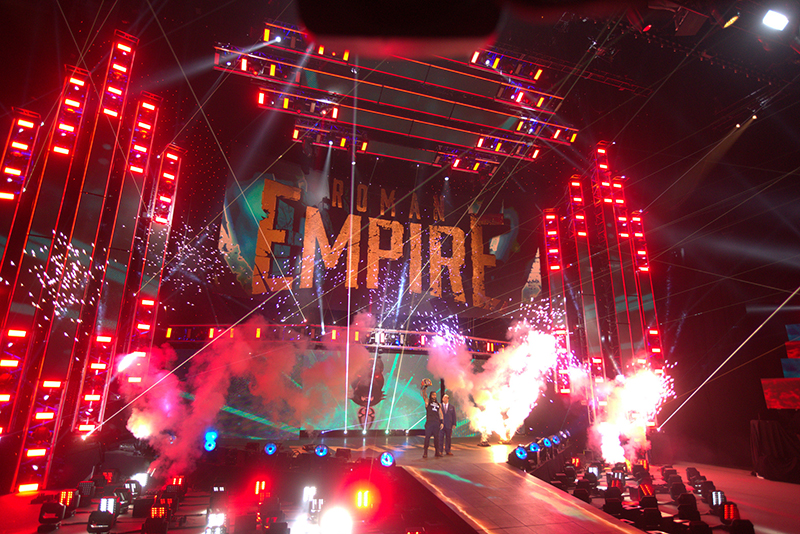
It took three days getting the audience concept designed and approved. Robinson began on the second part of the overall design, which was the Thunderdome. “When we finally got the okay, we were on our way to the last two days of taping. It was a photo finish to get the gear for the Thunderdome in trucks and out the door to Orlando. We were able to do that with the help of all our great vendors — ARS, Upstaging, Screenworks, Strictly FX and Atomic,” he says.

Upstaging: From PPE to WWE
“The good news is we had the resources available,” says John Huddleston from Upstaging. “We know we need to jump on anything WWE has brewing. We’re always ready when they call. We sent four trucks of VL6000’s, Claypaky Sharpy’s and all different kinds of Ayrton MagicPanels, and they totally tapped us out for more Hippo Boreal servers. And a lot more control to support the virtual audience wall.”
The call from WWE instigated an abrupt shift from Upstaging’s concentration on producing PPE. “It was good — it kept everybody here. At least the folks that live in the Chicago area. We wanted to keep them working. We powered through by building things we didn’t think would be available right away. We sold a quarter of a million face shields. We had lighting technicians and video technicians building shields of all types. So we kept the family working, and we kept trying to meet the needs that are out there for PPE.
“The nice thing about having everybody here is that I can go back in the warehouse and say, ‘Look, we all need to jump on building this thing for WWE.’ And they make it happen. So, the guys have been jumping back and forth between building PPE and doing these live stream events. That is the thing we said from the beginning — we’re gonna do this stuff; hopefully keep paying the bills — and we’re still here.
“WWE is a fantastic partner. They are doing a great job of doing what they can to get by. They are so creative, and it is a real dream to work with them. Jason is the hardest-working designer in showbiz. I admire his energy and professionalism. He works harder than any designer I have ever seen. He is constantly tasked with new things they want to present, and he is constantly drawing. Every day. It is an honor to support him and WWE.”
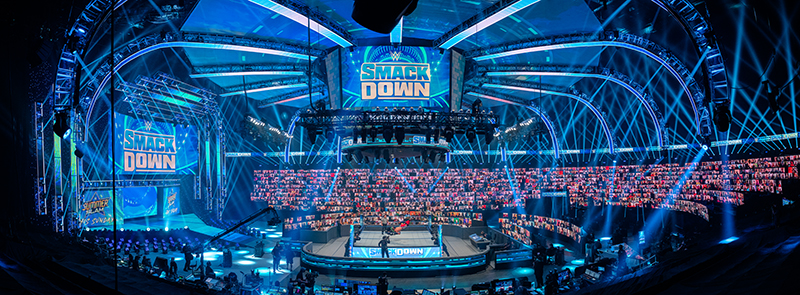
Atlanta Rigging Systems
Half of the WWE staff was at the Performance Center on Friday Aug. 14. They unloaded all the tour gear and started rigging in the Amway Center when the rest of the gear showed up. Along with the rigging, circles, and truss for the Thunderdome, “Dave sent an amazing amount of 12-inch truss for the goal posts that held the audience LED tiles, and his guys on site kicked ass,” says Robinson.
The ARS crew carried “miles and miles” of 12-inch truss and baseplates up into the seats and created goal posts that went the length of the seats. Screenworks then went in behind them and hung all the video. ARS designed and fabricated about 700 brackets to mount the video tiles provided by Screenworks to the curved and vertical fingers of the Thunderdome.
“Yes,” says Dave Gittens GM of ARS, “we did a good amount of work on the show, which wound up being eight trucks of additional gear with what we already have out there on tour. The concept was floated on Monday, approved on Wednesday, and shipped and installed on Saturday in the same week. Our lead rigger Alan Jamnik does an amazing job bringing it all together on site. Jason thinks fast and moves on quickly. Alan has problem-solving skills and serves as translator between Wrestling and rigging. The many challenges that present themselves in the WWE universe ultimately make ARS better and more efficient every week. This was no exception, and ARS is grateful to be part of the grand scheme in WWE’s Thunderdome residency.”
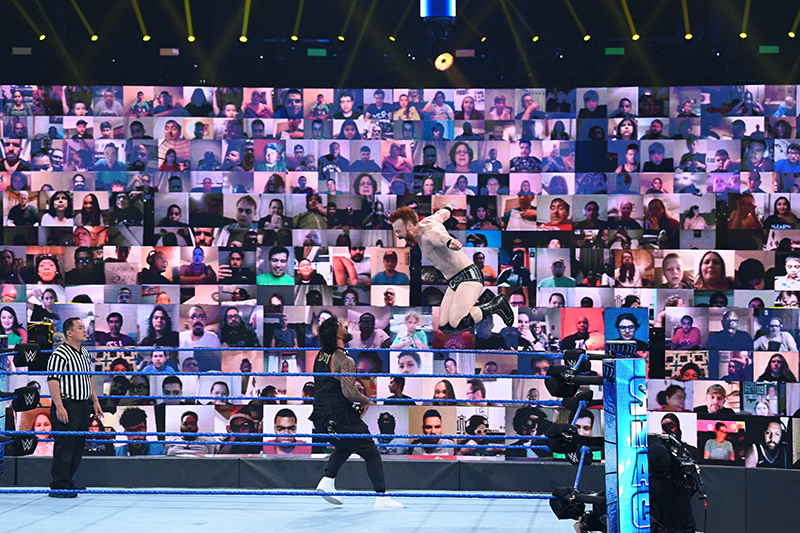
NEP Screenworks
“Everybody who has seen this, wants it,” says NEP Screenworks vice president Kevin Hoyle, speaking of the virtual audience creation. “It is a great concept. Jason once again knocked it out of the park, like he always does. The Thunderdome is phenomenal. Once Jason gives out the design, the team that comes behind it — the usual vendors we have been working with closely for years — are all outstanding. I sent a crew of 22 because this was such an incredibly tight time frame.” Hoyle also had to send a truck from his West Coast office, though he has a Nashville facility.
“We have 64 primary processors in use on that show,” Hoyle adds. Screenworks provides all projection and LED screens. For the Thunderdome, NEP provided an additional 32 projectors set on the floor shooting onto the “roof.” Atomic found enough Textilene and sewed and sent it down for use as the projection material to create and stretch across the roof of the Thunderdome.
“It is a massive video show. We forward and reverse signal in each direction, since it is live TV, which is a bit of a challenge in itself. At one point, I just threw a truck of Kak together so there was no way we would come up short — cable, fiber, distros, extra projectors, extra everything. Since we didn’t know where it would trim out, we wound up sending three lensing selections.
“It was a challenge, and really interesting, as all of them are,” Hoyle adds. “But I think if not for the team that is assembled as vendors that we have worked together with over the years, it would not have happened in the short timeframe we had.”
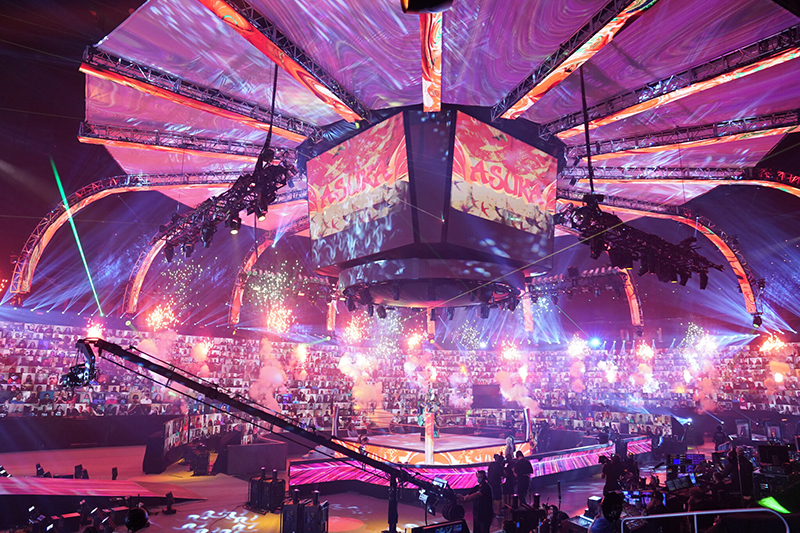
Strictly FX
“The turnaround time is the main challenge here,” says Eddie Romack, SFX designer. “When the idea of the Thunderdome and this virtual audience concept was brought to us, the brief was, ‘How can we continue to make this show the spectacle that it is?’ How to bring an arena alive, like a stadium show.”
The pros and cons of having a live audience inside an arena now were blurred somewhat. A lot of constraints did not apply. Romack and his FX team could recreate a complete roof wraparound that is usually only allowed outside, at a stadium. This gave Strictly a huge canvas to paint on the Thunderdome. Pyro, smoke, lasers — there were no holds barred.
“Jason has a ton of inspiration that he kicks my way; always looking for what is new and innovative,” says Romack. “At the same time, he gives me the freedom to pitch. We are always creating together. For this, he wanted us to bring everything and anything we could to make it the spectacle that it is. With that in mind, we still have to always be aware of where we place our FX. With the projection overhead, that limits where we can shoot. But this show is all about the camera.”
Audience scanning lasers ranging from 3W to 100W were used and pointed more directly at the cameras, which gives a brighter effect. Romack was able to direct the laser beams towards parts of the arena where there would normally be people. The show set a company record for number of lasers on an event, with just over 100. “One of things I do hold close and love about this show is, they are always looking how to break the bounds and make something spectacular, which is exactly what they did with the Thunderdome.”
It All Comes Together
“The special FX portion of the Thunderdome presentation are second-to-none right now,” says Jeremy Shand, production manager for WWE. “Fortunately, we work with some of the best vendors out there. They all know we turn on a dime. Trying to pull something off that big, that fast, when every company is working on limited resources due to the pandemic, is a bit of a challenge. It was quite a feat by all the folks involved.”
Particularly when one realizes the rigorous protocols set in place to observe all the Covid -19 protections and testing routines. These are absolutes mixed in with the intense nine days. The WWE production staff procured as much sanitizing materials as possible before the mad rush got started. “Everybody came to work realizing this is our livelihood, so we all worked to be safe,” says Shand.
Which is just one of many reasons why the WWE organization works equally hard at protecting their staff, their superstars, and all their vendors when putting on the Thunderdome Raw and Smackdown events now broadcast from the Amway Center. “We isolate our crew as much as we can. Our vendors each have their staff on site to look after their gear, but on site, everybody is the same crew. Everybody is working on everything, every aspect of the show together. Once we are together in the arena, there is no separation of church and state, the lines between departments become blurred very quickly. It is a very singular crew right now, very much a family,” states Shand.
This was a byproduct of trying to keep the number of people on site as small as possible; keeping everything as much of a known entity as they could. “Still, though, it takes a very large group of people to pull off the show each night,” says Shand. “And everybody is doing all they can to keep themselves and the people around them safe. The Amway Center staff is working closely with our organization to ensure the site remains sanitary and virus free.”
Sums up Robinson, “We worked five days to get the system in and ready to turn over to our programming staff. Our front of house team — Jeff Wilkin, Chris Keene, AJ DiCarlo, Steve Barringer and Charles Perry — had about 36 hours to get the show programmed for opening night of Smackdown Live on Fox, knowing we had to be ready Friday afternoon for the rehearsals and the superstars coming in. It was a very challenging time, but very rewarding when everyone looked at each other and just said, ‘Wow, that was amazing’ when we finally got on air.”
WWE Thunderdome
Crew
Upstaging: Matt Massoth, Nick Becker, Jason Blaylock, Austin Kenney, Mars Mescudi, Matt Partch, Matt Rodewald, Jonathan Schneider, Mark Powell, Robin Sheridan, Kyle Rutkowski, Mike Hosp, Tony Thompson
ARS: Alan Jamnik (lead rigger), Delshay Coplin, Morgan Prine, Ron Dennis, William Taylor, David Ridinger, Eric Lemaine, Mike Shields, Josh Hunter, Rowan Philips
Screenworks: Neil Broome, Jeff Hoyle, Andre Nolan, Eric Nickloy, Matt Mueller, Jason Lowe, Shawn Woolard, Jason Keyes, Garrick Terveer
Gear
Upstaging: Four trucks of lighting gear (Vari-Lite VL6000’s, Claypaky Sharpys, Ayrton MagicPanels), plus control systems for the virtual audience wall that included Upstaging’s full inventory of Green Hippo Boreal media servers.
ARS: 300 points and 2,500 linear feet of truss, including (3) 20.5” x 40’ radius circle truss, (1) 20.5” x 50’ radius circle truss, (1) 20.5” x 60’ radius circle truss and (1) 20.5” x 80’ radius circle truss.
Screenworks: Video tile package including (1,458) 7mm tiles in seats of arena, (480) 7mm tiles in Thunderdome truss above the wrestling ring, (32) 7mm tiles for the ring barricade, (216) 5mm tiles for the floor seats, (72)5mm tiles for the backstage set and (80) 5mm tiles for the backstage set.
Video projector package including (32) 20K projectors for the Thunderdome (16 live and 16 hot back up).
Video screen processing package including (64) NovaStar NovaPro processors (32 live and 32 hot back up), (6) NovaStar VX4 processors (3 live and 3 hot back up) and 12 NovaStar CVT’s.
Atomic: Textilene projection material.
Related links: www.atlantarigging.com, www.upstaging.com, www.screenworksnep.com, www.strictlyfx.com, www.thefamousgroup.com/#1, www.atomicdesign.tv


